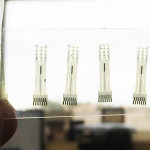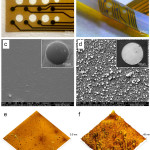
WHY THIS MATTERS IN BRIEF
In the future we’ll communicate with machines and other people using a form of telepathy, these new glassy carbon sensors just moved us another inch forward.
Over the past few years advances in the field of Brain Machine Interfaces (BMI’s), which are essentially interface systems that read our brainwaves and translate them into actions – whether that’s creating telepathic links with industrial robots, or each other – and an improved understanding of how our brains work have helped transform the lives of people around the world, for example, with ALS or locked-in syndrome.
In turn these advances have given hope to researchers who are trying to find new ways to combat the negative effects of neurodegenerative diseases and improve the lives of people who have to use prosthetics but in order to realise the next step, and realise the potential of BMI systems the technology has to mature. Advanced as they are now, BMI’s, for the most part, still rely on implantable chips and electrodes that are placed on the brain’s surface to receive and transmit signals from brain chemicals known as neurotransmitters.
Today’s state of the art electrodes are made from thin-film platinum and are highly susceptible to corrosion, which, bearing in mind many of these electrodes are implanted, isn’t a good thing, so now the Center for Sensorimotor Neural Engineering (CSNE) – a partnership between San Diego State University, the University of Washington, and MIT – are working together to develop new electrodes. Their study is published in the journal Nature Scientific Reports.
Instead of using platinum, the researchers, led by CSNE deputy director Sam Kassegne, developed electrodes built from a form of carbon called “Glassy carbon.”
“Glassy carbon is much more promising for reading signals directly from neurotransmitters,” said Kassegne, “you get about twice as much signal-to-noise. It’s a much clearer signal and easier to interpret.”
In short it’s a much better material to use and will help produce even more accurate brain reading results. Furthermore, because it’s ten times smoother than granular thin-film platinum, it corrodes more slowly, but the researchers think that glassy carbon can do much more than just improve brain signal transmission and they’re using it to create new types of BMI’s that can record neural signals along the brain’s cortical surface and from inside the brain at the same time.
“If you record from deeper in the brain, you can record from single neurons,” explained researcher Elisa Castagnola, “on the surface, you can record from clusters. This combination gives you a better understanding of the complex nature of brain signalling.”
But another potential application is even more promising. Mieko Hirabayashi, a student in Kassegne’s lab, is exploring the possibility of using glassy carbon to help re-grow damaged nerve cells in spinal cords by using it to electrically stimulate cellular repair and regeneration – something that’s been shown to work in the past. Without the new glassy carbon electrodes, Hirabayashi wouldn’t be able to stimulate, read the electrical signals from, or even simply detect the neurotransmitters responsible for regeneration as easily.
With all the successes that existing BMI technologies have produced, it’s not difficult to imagine a future in which a true merging of human and machine is be possible. Improvements such as CSNE’s research bring this future closer to today’s reality.


















[…] Source link […]
[…] that seems a little low tech and “traditional” for Musk, or we could opt to go full cyborg and implant sensors directly into our brains – but that’s too invasive, and again it doesn’t seem to fit Musk’s […]
[…] treating, and curing, paralysis that include the development of artificial neurons and cyborg implants, to brain chips and new graphene based treatments. In fact the breadth of treatments are getting […]
[…] help patients with Locked In Syndrome (ALS) communicate “telepathically”, like these new “Cyborg” BMI sensors that were developed last year, are invasive and need surgery to be implanted into […]